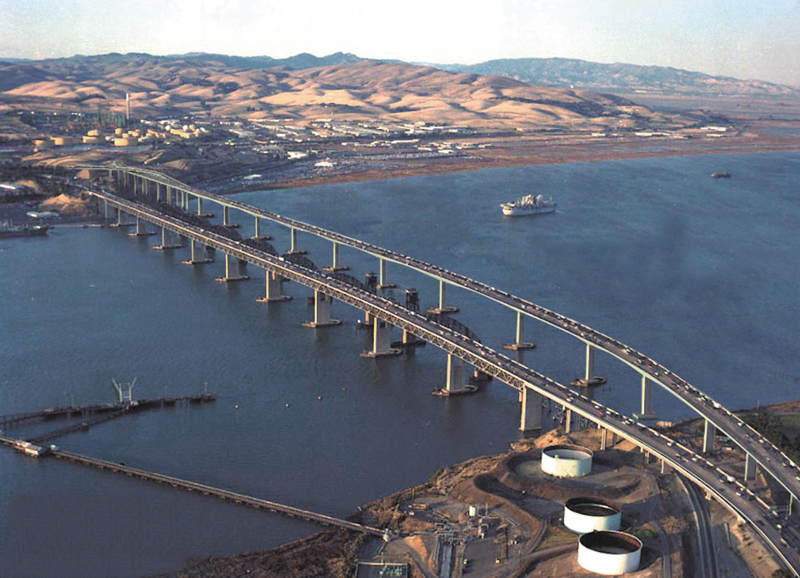| |||||||
Europe
North AmericaSouth AmericaAsiaAustralia and OceaniaAfrica |
Ñìîòðèòå òàêæå: Benicia–Martinez Bridge The Benicia–Martinez Bridge refers to three parallel bridges which cross the Carquinez Strait just west of Suisun Bay; the spans link Benicia, California to the north with Martinez, California to the south. The 1.2 mile (1.9 km) deck truss bridge opened in 1962 as a replacement for the last automotive ferry service in the San Francisco Bay Area. The 1962 bridge consists of seven 528-foot (161 m) spans which provide 138 feet (42 m) of vertical clearance, carrying three lanes of traffic in the southbound direction. (Planned upgrades will provide four lanes of traffic and a bicycle/pedestrian lane.) A 1.7 miles (2.7 km) bridge was built alongside and opened on August 25, 2007 which carries five lanes of northbound traffic. The cost to construct the 1962 span was US$25 million and US$1.3 billion to build the 2007 span. The bridge is part of Interstate 680, itself a major transportation link, and connects several other heavily traveled freeways. Between the two vehicle bridges is a railroad bridge owned and operated by the Union Pacific Railroad. The railroad bridge was the first bridge at this location, built between April 1929 and October 1930 by the Southern Pacific Railroad. It is used by Union Pacific and BNSF (trackage rights) freight trains, as well as 36 scheduled Amtrak passenger trains each weekday. Passenger trains include the long-distance trains California Zephyr and Coast Starlight as well as Capitol Corridor inter-city commuter trains. The Interstate 680 bridges, i.e. the two automobile spans, are usually referred to simply as "the Benicia Bridge."
Benicia–Martinez Bridge Official name George Miller, Jr. Memorial Bridge(southbound span), George Miller III Bridge (northbound span) Carries 8 lanes of I-680 Crosses Carquinez Strait Locale Martinez, California and Benicia, California Design Truss bridge (southbound span), segmental bridge (northbound span) Longest span 528 feet (160.93 m) (7 spans) Total length 1.7 miles (2.7 km) Clearance below 138 feet (42.1 m) Adjacent railroad bridge A railroad bridge owned by Union Pacific Railroad spans the waterway between the two vehicle bridges. The railroad bridge was built for the Southern Pacific Railroad between 1928 and 1930. Prior to the railroad bridge's opening in 1930, the railroad used a ferry between Benicia and Port Costa, California. The ferry, built at Oakland, California in 1879 and named the Solano, was the world's largest train ferry. In 1914, a second ferry named the Contra Costa was built. The ferries ended service in 1930 with the completion of the railroad bridge. Northbound span A newer bridge was constructed east of and parallel to the railroad bridge. It measures approximately 1.7 miles (2.7 km). The new bridge carries five lanes of northbound traffic. The older bridge is undergoing seismic retrofits and will carry four lanes of southbound traffic, as well as a bicycle/pedestrian lane. The bridge construction also included a new toll plaza with nine toll booths, two open road tolling lanes and one carpool lane at the south end of the bridge, although tolls will continue to be charged only for northbound traffic. The new toll plaza was retrofitted for open road tolling in order to encourage increased FasTrak usage. This required the removal of eight toll booths previously constructed. The bridge is the largest lightweight concrete segmental bridge in California. The estimated cost of building the bridge was $1.05 billion, the final cost was $1.3 billion. The bridge original estimated cost was around 300 million, it is noted for is large delay in construction and large over cost (over $1 billion). The new bridge opened to public traffic at 10:30pm on August 25, 2007. Comments: 0 |
|
|||||







































